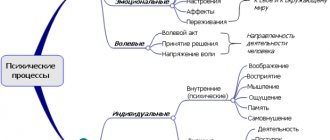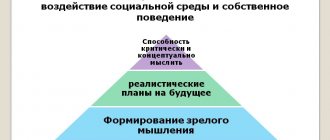Only a specialist can make a diagnosis of neurosis or schizophrenia. Recently, neurotic conditions have become widespread, which are often subject to incorrect diagnosis and untimely treatment.
The life of a modern person is full of stress and difficult emotional experiences, which affect his mental health.
Fundamental differences between states
A neurotic, unlike a schizophrenic, maintains a critical attitude towards his condition. He realizes that he has problems, he is overcome by fear that something bad might happen to him. As a result, the neurotic person actively tries to understand his condition, he goes to doctors and undergoes examinations. Having failed to find objective confirmation of the patient’s complaints, doctors refer him to a psychotherapist.
In psychosis, completely different behavior is observed. While in this state, the patient is unable to name the current date, clarify his location, perhaps he even identifies himself with another person. The patient's basic mental functions are split - thinking, will, emotions. Even after emerging from psychosis, one cannot definitely talk about the norm: the person is somewhat uncritical of the world around him and himself, he is detached, his behavior is strange, his statements are ridiculous, and his manner of expressing emotions is puzzling. The patient is burdened by misunderstanding of himself, loss of will and emotions. But he is in no hurry to see doctors, and tries to hide his problems.
Hallucinations
Deceptions of perception - hallucinations and delusions - often overtake schizophrenics in a state of psychosis. Neurotics also have such disorders. But for them they are simple in content and short-term, and appear more often when falling asleep or upon awakening. For neurotics, these are more likely repetitive thoughts or melodies, parts of heard remarks. It can also be a visual image - a spot of light or dots, patterns or pictures.
In schizophrenia, hallucinations are violent. The voices argue, criticize the “owner,” instilling fear in him. The patient feels someone's influence on him, as if someone is forcing him to do something, say something, or interfere with his body. The patient may be “exposed” to the action of certain rays or devices.
The schizophrenic is sure that the voices speak to him alone, and only he is able to hear them.
Rave
Delusional ideas are the exclusive prerogative of schizophrenics; neurasthenics do not have this disorder. It is impossible to convince the patient of the absurdity of such beliefs: he will withdraw or respond with aggression. In schizophrenics, delusions are systemic in nature, completely replacing the real perception of the environment.
Distinctive features
The main difference between schizophrenia and neurosis is that during the course of the second pathological process the patient can be critical of himself. The patient tries to understand himself and understand what is happening in his body. When problems occur, patients independently seek help from specialists. If there are no symptoms of a physical illness, the patient should consult a psychotherapist.
Neurosis can be distinguished from psychosis in accordance with other behavioral signs. Patients are lost in time. The disease is accompanied by loss of coordination. After the end of the acute period of psychosis, it is difficult to say that the patient is in a normal state. The patient experiences a decrease in criticism towards the events that surround him. When a person does not understand himself, his well-being decreases.
Diagnostics
The fundamental difference between neurosis and schizophrenia is the preservation of the personality of the neurotic.
The patient experiences weakness, he is in a bad mood, but his personal qualities such as individuality, emotionality and determination remain. Neurosis is a reversible disorder. After a course of psychotherapy, the patient is able to return to normal life, he knows how to react in a new way – correctly – to conflict situations and to emerging difficulties.
Over the years, a schizophrenic person develops apatho-abulsic syndrome, when a personality defect manifests itself - and grows over the years. He becomes lethargic, his ability to express emotions is narrowed. Fear, voices, delirium and other related symptoms increase over time. The patient is uninitiative and moves further and further away from the real world, plunging deeper into the world of his own painful fantasies. This condition leads to disability, even to the point where a person is unable to care for himself independently.
To overcome the fear of making a fatal diagnosis, it is worth taking a test for neurosis. The online versions are quite informative and simple, but you must first read the instructions. A doctor can also perform the appropriate test.
Notes
- ↑ 1 2 3 4 N. N. Ivanets, Yu. G. Tyulpin, V. V. Chirko, M. A. Kinkulkina.
Psychiatry and narcology: textbook. - M.: GEOTAR-Media, 2006. - P. 473-474. — 832 p. — ISBN 5-9704-0197-8. - O'Connor K., Connor K. O., Nelson B., Walterfang M., Velakoulis D., Thompson A. (2009). "Pseudoneurotic schizophrenia revisited." The Australian and New Zealand journal of psychiatry 43
(9): 873–876. DOI:10.1080/00048670903107658. PMID 19670061. - ↑ 1 2 V. M. Bleikher, I. V. Kruk.
Neurosis-like schizophrenia // Explanatory dictionary of psychiatric terms. - MODEK, 1995. - ISBN 5-87224-067-8. - World Health Organization.
Section V of the “International Statistical Classification of Diseases, Injuries and Causes of Death, 9th Revision”, adapted for use in the USSR. - M., 1983. - P. 29. - World Health Organization.
Class V: Mental and behavioral disorders (F00-F99) (adapted for use in the Russian Federation). Part 1 // International classification of diseases (10th revision). - Rostov-on-Don: Phoenix, 1999. - P. 125. - ISBN 5-86727-005-8. - T. S. Syunyakov, E. S. Teleshova, S. A. Syunyakov, V. V. Koshelev, G. G. Neznamov.
Features of the therapeutic action and effectiveness of rispolept consta in patients with pseudoneurotic schizophrenia (results of an open study) // Psychiatry and psychopharmacotherapy. - 2006. - No. 4. - ISSN 2075-1761.
Neurosis-like schizophrenia
Pseudoneurotic schizophrenia is one of the forms of schizotypal disorder, i.e. it does not apply to schizophrenia in the classical sense of the term, as reflected in the ICD-10 classification.
In this state, a person can live more or less comfortably for 10-30 years. During this period, manifestations of psychopathic, neurosis-like, erased affective, depersonalization and paranoid disorders are possible, i.e. the patient is more tormented by fear and neurosis. In such a patient, the personality defect does not progress, there are no hallucinatory-delusional symptoms, the following is observed:
- strange character;
- emotional lability;
- an unreasonable craving for the study of philosophy, mystical teachings, abstract theories;
- loss of interest in one's own appearance;
- the emergence of highly valuable ideas;
- fear, apprehension;
- decline in life productivity.
People remain socially active, although their education is rarely complete. The patient can work, but not constantly. He tries to find a workplace where there are no special problems and no effort required. The patient rarely starts his own family. The existing fear progresses. For example, if a patient was afraid to ride a tram, then over time he will stop using any means of transport. He will be tormented by fear, perhaps taken to the point of absurdity. With neurosis, a person tries to overcome these sensations - he performs certain manipulations to calm down, utters some phrases.
Therapy in this case is psychotherapeutic work (both in a group and individually) and assistance in social adaptation, sometimes the doctor prescribes mild sedatives.
According to WHO statistics, the prevalence of overt forms of schizophrenia is 0.8%, and low-grade forms of schizophrenia are 2-3%. However, you need to understand that one state cannot change to another. These are different diseases.
Dysmorphophobia in the structure of pseudoneurotic schizophrenia
Let's assume that the patient, let it be a woman, suffers because of her dysmorphophobia. She thinks she has a terrible nose and terrible ears. Progression is observed. She already caught herself wanting to take a knife and cut off her ugly nose. She went to plastic surgeons, and they changed her nose and the shape of her ears. But they didn’t do anything with the psyche. And so the patient looks in the mirror and again sees a freak there. She screams that things have gotten worse.
Worth seeing: Regular schizophrenia
Before the operation, she was an obvious freak, and now she is also an obvious freak with a crippled nose. Without a doubt, the intervention of psychiatrists is necessary. Try to lure her somehow. This requires the real art of diplomacy and persuasion. It’s not that the nose is normal, which cannot be mentioned, but that she needs the help not of a surgeon, but of a psychotherapist. You need to convince her that she has overloaded her psyche with these terrible problems, and a psychotherapist will help relieve stress.
Therapy
In case of neurosis, psychotherapy helps first of all; in rare cases, they resort to the help of psychotropic drugs. They are prescribed for a short period of time and used as maintenance therapy.
Schizophrenia is treated primarily with medication. The drugs are prescribed in long - sometimes even lifelong - courses. Specific psychotherapy is used for intact patients.
We recommend watching:
We recommend reading:
When do phobias become neurosis?
Previous article
Relaxation against neurosis
Next article
How to cure psychopathic schizophrenia
Psychopathy is a form of psychosis accompanied by personality pathology, cynicism, aggressive behavior, a tendency to use drugs and alcohol, and callousness. These signs are characteristic of a mild neurosis-like form of schizophrenia.
With the nosology, social adaptation is disrupted, the psyche suffers, but delusional-hallucinatory syndrome rarely develops only in acute cases.
Doctors first started talking about psychopathy in 1884, when the term “psychopath” appeared in medicine. The nosology was identified after studying the condition of a certain defendant who committed a violent act against a friend. When trying to determine the woman’s sanity, psychiatrists determined that the defendant did not have any significant mental pathology to consider her insane.
Advice
At the same time, experts identified a new nosological form, indicating some abnormality in the patient’s psyche. Such people, due to their temperament, have increased anxiety. Sometimes, during times of great excitement, they commit actions that are contrary to morality.
Subsequent study of psychopathy led to the identification of new signs of the disease with acquired and congenital traits. Significant difficulties are caused by identifying nosology at an early stage.
People with psychopathic-like schizophrenia are characterized by severe excitability and irritability. The lack of an adequate assessment of one's own capabilities sometimes leads to suicidal behavior. Egocentrism is a typical state of psychopaths.
For many years, patients with these diseases do not experience any improvement in their condition, but they also do not show any progression. The lack of dynamics in psychopathic schizophrenia is not the only manifestation, as intelligence gradually decreases.
With early treatment, it is possible to prevent rare signs of exacerbation, which can lead to harm to others and suicide attempts.
To cure psychopathic-like schizophrenia, identification of pathological character traits is required. Different forms require a selection of unique medications.
For cases with depressed mood, antidepressants (amitriptyline, rudotel, phenazepam) are recommended. If there is a tendency to aggressive behavior, the use of antipsychotics (triftazine, etaprazine, sonapax) is recommended. Medicines are prescribed especially often for sleep disorders. When using medications, addiction is likely to develop, so they must be taken with strict adherence to the dose. Anticonvulsant medications such as carbamazepine are prescribed to correct mood when there are significant diurnal fluctuations.
Alcohol and drugs are not recommended against the background of psychotropic use. The combination of these substances leads to the most unexpected and dangerous consequences.
Only a qualified doctor who can optimally select a medication regimen can cure psychopathic-like schizophrenia.
During treatment, you should refrain from using transport. To properly treat psychopathy, you should select a nurse who will ensure that the patient carefully takes the dose of medication.
Without a doctor's prescription, you can purchase mild sedatives such as valerian officinalis and novopassit at the pharmacy, which you can use on your own. High-quality results in the treatment of psychopathy are achieved not only with medications, but also with psychotherapeutic techniques. In Europe, to get rid of pathology, the patient undergoes psychoanalysis. The course of therapy is long, but it should be carefully followed.
The described methods form the basis for the treatment of psychopathic schizophrenia. Together with them, the following measures are recommended for complex treatment:
- Taking herbal mixtures based on lemon balm, hops, valerian officinalis, which have a calming effect;
- Aromatherapy using marjoram, lavender, hot baths.
During treatment, it is necessary to give up bad habits - alcohol abuse, smoking, drug use.
If mental symptoms are severe, inpatient treatment is recommended, where each symptom is monitored by specialists in order to quickly relieve acute conditions in which a person can cause harm to himself or others.
Classification and stages of development of schizotypal disorder
It should be noted that the course of this disorder follows the general patterns of the course of endogenous diseases, i.e., it goes through stages: latent stage, period of full development of the disease, period of stabilization. However, schizotypal disorder also has its own characteristics.
The main manifestations are:
- long latent, “hidden” period with further activation of painful manifestations;
- a tendency to modify symptoms from mild to more pronounced during the active stages of the disease;
- the invariance of a number of symptoms, such as: obsessions, phobias, etc.
It should be noted that within the framework of schizotypal disorder, several clinical variants are distinguished. Thus, there are variants with a predominance of pathologically productive and negative disorders. The first will include pseudoneurotic and pseudopsychopathic options.
Let's take a closer look at the characteristics of each option.
Schizotypal disorder with a predominance of negative disorders is characterized by “poverty” of symptoms and the predominance of asthenic conditions in the clinical picture. According to ICD-10, schizophrenia is “poor in symptoms.” Also, subtypes of schizotypal disorder include “schizophrenic reaction”, pseudoneurotic (neurosis-like) schizophrenia, pseudopsychopathic (psychopathic-like) schizophrenia.
Pseudoneurotic (neurosis-like) schizophrenia is manifested by symptoms that resemble neurotic manifestations (these may include phobias, obsessions, hypochondriacal experiences).
Pseudopsychopathic schizophrenia or psychopathic-like schizophrenia is another subtype of schizotypal disorder that is characterized by personality changes and behavioral disturbances. This type of disorder is characterized by antisocial behavior, unscrupulousness, unmotivated cruelty, strange hobbies, as well as disinhibition of drives and absurd actions, such as, for example, leaving home for no reason.
A schizophrenic reaction (schizophrenic reaction) is a condition that occurs in connection with the presence of a severe psychotraumatic situation and is characterized by schizophrenia-like symptoms. The duration of such a reaction can be several days, weeks, and then pass without a trace. [10] [11] [12]
Treatment
The course of therapy is individual in each case. It depends on which clinical manifestations come to the fore and which remain secondary. Our psychiatrist will select medications and dosages, taking into account the specific course of the disease. These are mainly antipsychotics, mild tranquilizers and antidepressants.
After eliminating phobias and obsessive states, the patient is supplemented with psychotherapy . Individual sessions with a doctor help the patient realize the groundlessness of his obsessions and fears, while group sessions help restore communication skills and establish contacts with those closest to him.
At the “Balance” clinic you can undergo treatment on an outpatient basis or in a hospital setting. For this we have all the necessary conditions - bright, comfortable rooms of various categories, polite and competent medical staff, experienced psychiatrists, modern equipment. If you cannot come to our clinic for a consultation with a specialist, use an online consultation or a doctor’s home call service. We work around the clock, so we will arrive at any time. Our clinic phone number: +7 (499) 495-45-03.
Pseudopsychopathic schizophrenia, treatment of psychopathic schizophrenia - CMZ "Alliance"
It is not possible to completely cure a personality disorder. There are some methods of psychotherapeutic influence that can establish a balance of emotions for an indefinite period of time.
The most well-known methods of therapeutic intervention for people suffering from various forms of psychopathy are:
- autogenic training;
- hypnosis;
- explanatory psychotherapy.
Among the methods of psychotherapeutic influence on psychopaths, the most common is hypnosis.
Inpatient treatment of advanced forms of personality disorder includes additional doses of antidepressants and antipsychotics. You can also treat with medications aimed at correcting behavior.
Of the entire population of the planet, only 2% of people are diagnosed with a personality disorder. In fact, psychopaths can be in any environment without expressing themselves. Some, for example, hereditary psychopaths, carefully hide attacks of aggression and try to correct behavior on their own, without resorting to the services of psychotherapists.
Important to remember! Not every psychopath is prone to commit crimes, just as not every criminal has a personality disorder.
Pseudopsychopathic schizophrenia is one of the variants of schizotypal disorder (previously referred to as low-grade schizophrenia), in which psychopathic-like symptoms come to the fore: pathological desires, cruelty, frequent uncontrollable outbursts of rage, coldness, obsession with unusual interests. This is a chronic disease that is well controlled and has a favorable prognosis with quality treatment.
It can be difficult to differentiate from personality disorders. It is most often observed in adolescents, although it can develop at any age.
Important
In the absence of treatment or refusal to follow the recommendations of a psychiatrist, the disorder can develop into classic schizophrenia and maladjust the person to the point of disability.
note
In ICD-10 it corresponds to code F21.4 Pseudopsychopathic (psychopath-like) schizophrenia in section F21 Schizotypal disorder. Also in the literature there are synonyms “post-processual psychopathy”, “borderline schizophrenia”, “heboid schizophrenia”.
The question of the causes of psychopathic-like schizophrenia remains open. The leading one is the genetic approach, according to which gene defects lead to an imbalance of neurotransmitters in the brain system.
Treatment of psychopathic-like schizophrenia is aimed at stabilizing the condition, eliminating symptoms of the disease and social rehabilitation. In this case, therapy is divided into 3 successive stages:
- Stopping treatment to relieve acute symptoms, for example, an attack of rage and aggressiveness.
- Stabilizing therapy to stabilize the patient’s condition and prevent the progression of acute disorders, if any.
- Anti-relapse treatment aimed at preventing exacerbations after the end of primary therapy.
Therapeutic measures should begin immediately after the manifestation of the disease. Acute mental changes can progress rapidly, leading to social maladaptation, decreased quality of life and divergent behavior. There are several approaches to treatment: the use of drugs, the use of cell therapy, psychotherapy and detoxification of the body.
The average duration of therapy is 9 months. It takes 3-6 weeks to relieve acute psychosis. Subsequent treatment allows you to normalize the psyche and prevent relapses in the future. The patient must undergo social and labor rehabilitation.
For psychopathic disorders, individual psychotherapy comes to the fore, especially relevant for adolescents. After establishing a trusting relationship, patients often feel the need to talk with their doctor about a variety of, sometimes unexpected, topics. Such interviews help you rethink your behavior and give the doctor new options for correction. Group psychotherapy is used to teach a person how to be in society and interact fruitfully with people.
Medications relieve acute symptoms, and psychotherapy allows long-term and stable remissions to be achieved.
In the treatment of psychopathic-like schizophrenia, drugs from the main classes of psychotropic drugs are used:
- neuroleptics;
- antidepressants;
- tranquilizers;
- nootropics;
- mood stabilizers.
Medicines are chosen depending on the leading symptoms. Modern drugs have a combined effect and should be prescribed individually, taking into account the symptoms of age, gender, and concomitant diseases. Regular monitoring by a qualified psychotherapist will ensure the effectiveness of treatment and reduce the risk of side effects.
Along with psychotherapy and pharmacotherapy, physiotherapeutic methods and physical therapy are widely used.
What is schizotypal disorder? We will discuss the causes, diagnosis and treatment methods in the article by Dr. E. V. Bachilo, a psychiatrist with 9 years of experience.
Treatment of the disorder in question, as a rule, begins on the initiative of loved ones and relatives, since the person himself rarely realizes the painfulness of the condition and, accordingly, does not understand the need to seek qualified help. First of all, drug therapy is necessary, which may include typical or atypical antipsychotics, as well as antidepressants and anti-anxiety drugs if appropriate symptoms are present.
Drug therapy allows you to normalize thought processes, eliminate aggression or irritation, and normalize behavior. If therapy is started on time and the drugs are selected correctly, as well as if maintenance therapy is taken, repeated attacks may occur after a very long time or may not occur at all. [21] [22]
One of the leading experts in the field of psychiatry, A.V. Snezhnevsky, recommended the use of stimulant drugs (psychostimulants) in cases where apathy, decreased activity and initiative, and lethargy come to the fore in the clinical picture. [23] Persons with schizotypal disorders are also advised to work with a psychologist and/or psychotherapist.
Group sessions and individual psychotherapy help improve social functioning and adaptation. [24] [25] There are methods of group multimodal psychotherapy that promote subjective improvement, reduce anxiety, build social confidence and improve communication skills. [26]
One of the treatment options for patients with schizotypal disorder, which is complicated by alcohol dependence, is creative self-expression therapy. The authors of this method emphasize that the use of creative self-expression therapy can increase alcohol remissions, “mitigate” the suffering caused by schizotypal disorder, and also improves the quality of life. [27]








